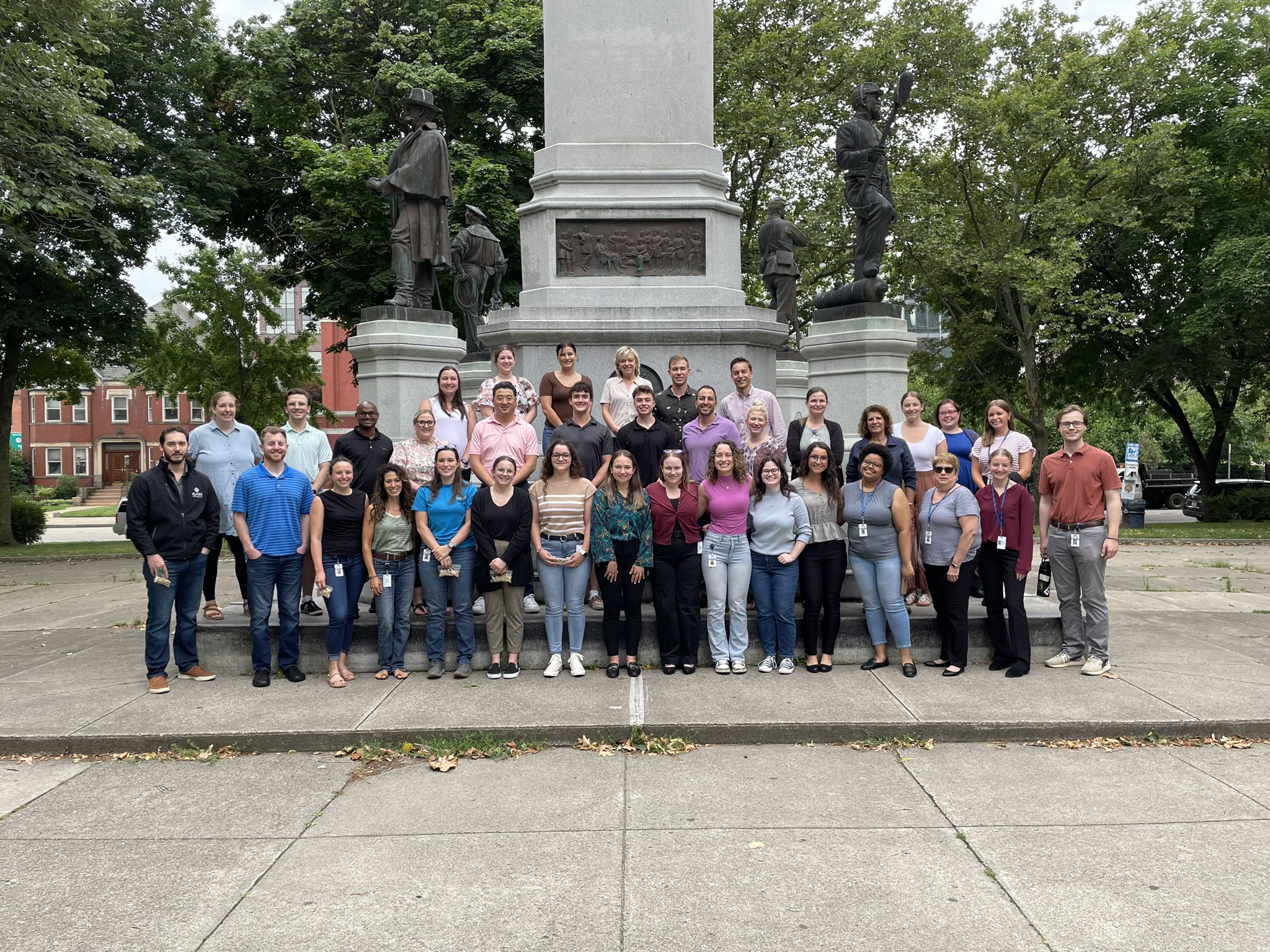PERSPECTIVE | July 23, 2024
Growth, inflation and hiring in the United States are all cooling toward a more sustainable pace, which will most likely define the second half of the year as the Federal Reserve gets ready to reduce its restrictive policy rate.
While the fiscal tailwinds that have bolstered the economy are abating, real wage growth and solid hiring will be sufficient to support overall growth at or near the long-run sustainable pace of 1.8%.
But growth in the current quarter will most likely slow to around 1.5% as private investment weakens because of elevated borrowing costs, slower government spending and a stronger dollar that dampens external demand for domestically produced goods and services.
The key to growth will be the labor market: Will hiring remain solid enough to sustain household consumption as domestic investment slows because of elevated financing costs?
To ascertain the health of the real economy, we focus on real final private domestic demand—demand excluding trade, inventory accumulation and government purchases—which increased by 2.6% through the first quarter.
At the beginning of the year, we forecast a growth rate of 1.8%, down from the robust 3.1% pace of last year; as the second half begins, the risk to the forecast is that the economy will perform slightly better than that estimate.
This overall slowing should result in the Federal Reserve reducing its federal funds policy rate by 25 basis points in September and December, which would put it in a range of 4.75% to 5%.
Such a rate would be consistent with a 10-year Treasury yield at or near 4.2%, which was our forecast at the start of the year.
If growth slows more than our forecast implies, there is downside risk to our year-end estimate of long-term interest rates.
Looking to the next 12 months, we anticipate only a 20% probability of a recession, barring externally oriented economic or political shocks.
Still, that forecast is 5 percentage points higher than our forecast for the first half of the year because there is an increasing chance that the Fed might be behind the curve when it comes to cutting rates.
A soft landing for the economy remains our base case, yet we cannot ignore the risks of the Fed keeping interest rates too high for too long.
Growth
During the first quarter, gross domestic product increased by 2.9% year over year and by 1.4% on a seasonally adjusted quarterly annualized pace.
Perhaps more important, real final private sales to domestic purchasers, which is our preferred measure of the American real economy, advanced at a sturdy pace of 2.6%.
We expect the pace of economic activity to ease toward 1.8% as real private domestic demand cools in the face of elevated financing rates and a slower pace of hiring. We expect job creation to slow to a pace closer to 120,000 per month compared to the monthly average of 222,000 during the first half of the year.
The risk, then, is that the unemployment rate will move modestly higher, which could cause household consumption to ease.
Private investment will continue to grow near 1.8% as the private sector ponders how and when to begin integrating the technological advances associated with artificial intelligence.
This is part of an encouraging trend in productivity, which we expect to continue to rise by 2% to 2.5%, even without the impact of artificial intelligence, which we do not expect to show up in the data until 2027.
We forecast the unemployment rate to increase from the current 4.1% to 4.2%, while inflation will slow from the 2.6% posted through the first three months to 2.3% in the second half.
The primary risk revolves around an unexpected resurgence of inflation and higher oil and energy costs.
Geopolitical risks linked to war in the Middle East and rising shipping costs caused by conflict in the Red Sea all play into those two risks.
In addition, the federal government is likely to continue running large deficits, regardless of which party wins the American presidency.
Financial markets may choose to push up long-term rates higher in the aftermath of the election, even though that is not our baseline forecast or the major risk to our rate forecast.
While there are differences between left-wing and right-wing populism, recent moves in fixed-income markets suggest that investors may push up longer-term rates following the election. Such an increase becomes more likely should new tariffs be imposed early next year.
Inflation
Goods disinflation and slower growth in service sector prices will continue to be the primary narrative inside the U.S. economy.
Service sector inflation, housing costs and insurance prices all will remain elevated but will ease.
Though inflation excluding housing, as measured in the personal consumption expenditures index, stands at 2%, the New York Fed’s multivariate core trend rests at 2.4%. The harmonized index of consumer prices, which measures housing costs differently than the consumer price index or the PCE index, stands at 1.95%.
The evolution of owner-occupied housing costs in the second half will remain a primary concern of consumers and policymakers.
The overall PCE index, the Fed’s preferred measure of inflation, has slowed to 2.6% through the end of May. We expect that pace to slow to 2.3% in the second half, which is just above the Fed’s 2% target and is why we expect the Fed to begin cutting rates in September.
The core PCE index—which excludes the more volatile food and energy components and is the best long-term metric of inflation—has also eased to 2.6%. Our forecast implies a further cooling to 2.5% at the end of the year.
The CPI, which is 33% housing, is cooling at a slower pace than the PCE index, which is 16% housing. That is the primary reason for the difference between the two.
Our forecast implies a further cooling in the CPI to 2.6% from 3.3% in Q1, which is down from the cyclical peak of 9.1% posted in June 2022.
Our longer-term outlook on inflation is that we do not expect a return to the level that existed from 2000 to 2020, when the average PCE index was 1.8%.
Instead, we expect to see inflation in the 2.5% to 3% range over the medium to longer term because of the changing framework of globalization, trade and supply chains and the intensifying geopolitical competition between the U.S. and China.
All of these factors will cause inflation to reset higher and require higher policy rates out of the Federal Reserve, resulting in a long-term terminal federal funds rate at or above 3% over the medium term.
Employment
During the first half of the year, the American economy generated an increase in total employment of 1.078 million jobs and averaged 222,000 new jobs per month. The unemployment rate averaged 3.9%.
But in the second quarter, hiring slowed to an average increase of 177,000, which is about halfway between the 150,000 and 200,000 that we think is the breakeven to keep employment stable. This is one of the primary metrics to monitor with respect to the ability of households to sustain demand.
In the short run, a move below 150,000 would almost certainly increase the probability of near-term rate cuts by the Federal Reserve. In addition, there are likely revisions to job gains that we won’t be able to observe until early next year, when the Bureau of Labor Statistics releases its benchmark revision.
Looking at previous changes, we think there is a clear risk of downward revisions that would potentially put the Fed further behind the curve.
In the longer run, given the strong demand for labor, it is important to note the role of demographics in the changing structure of the American labor market and how that may change given the upcoming presidential election.
Long-run demographic changes have led to a chronic shortage of workers and to higher wages, which have forced firms to adapt.
In recent months, the labor market has moved back into better balance and job openings have moved back to pre-pandemic levels. Demand for workers remains solid, and hiring across the service sector in general and in health care, education and government in particular is strong.
Over the past three years, roughly 7 million immigrants—2 million documented and 5 million undocumented—have entered the labor force, which is one of the reasons why the U.S. economy has outperformed, hiring has remained robust and spending has remained rock-solid.
It is highly likely that the outcome of the presidential election, no matter who wins, will result in a slower pace of immigration. Should there be extreme measures taken to curb inflation or actions that result in an exit of those workers, the unemployment rate could fall sharply, causing wages to rise and inflation to move higher.
For now, we expect hiring to remain solid, with 100,000 to 150,000 new jobs added per month, with a risk of a slightly slower pace near 100,000. This should result in a modest increase in the unemployment rate over the final six months of the year.
Interest rates
Financial conditions in the American economy stand at 0.3 standard deviations above neutral, which supports overall growth primarily because of modestly lower interest rates and strong gains in equity markets.
Our interest rate forecast, which we published on Dec. 5, indicated that we expected the 10-year U.S. Treasury yield would finish this year at or near 4.5%.
Our forecast implied that the 10-year yield would move between 4.25% and 4.5% with occasional moves above and below that range, and that is exactly what has happened.
During the first half of the year, the yield on the U.S. 10-year note averaged 4.29%, and we remain confident in our year-end forecast of 4.2%. We are not changing that forecast given the normalization of growth, inflation and hiring.
The risk to our estimate on Treasury yields is that rates will move lower than our forecast as market participants prepare for a more pronounced reduction in the policy rate next year. If that occurs, then rates on the 10-year yield will most likely range between 3.75% and 4%.
We expect the Fed to soon lay the groundwork for rate cuts in the second half of the year and the normalizing in the real economy to spill over into financial markets.
In that scenario, yields on the two-year and five-year notes will move lower, which would set the stage for the dis-inversion of the U.S. yield curve next year.
The takeaway
Normalization of growth, hiring and inflation implies a slower and more sustainable pace of activity and not a recession this year. We expect growth to increase by around 2% in the second half while inflation cools back toward 2%, hiring remains solid and unemployment increases to 4.2%.
Risks linked to higher inflation and energy prices are not going to abate anytime soon, primarily because of the external sector.
Long-run changes in the labor market, trade and industrial policy in the U.S. and the G7 all point to higher inflation and interest rates than we’ve seen over the past quarter century.
Let’s Talk
Fill out the form below and we’ll get back to you to discuss your specific situation.
This article was written by Joe Brusuelas, Tuan Nguyen and originally appeared on 2024-07-23. Reprinted with permission from RSM US LLP.
© 2024 RSM US LLP. All rights reserved. https://rsmus.com/insights/economics/as-the-economy-cools-the-fed-needs-to-cut-rates.html
RSM US LLP is a limited liability partnership and the U.S. member firm of RSM International, a global network of independent assurance, tax and consulting firms. The member firms of RSM International collaborate to provide services to global clients, but are separate and distinct legal entities that cannot obligate each other. Each member firm is responsible only for its own acts and omissions, and not those of any other party. Visit rsmus.com/about for more information regarding RSM US LLP and RSM International.




